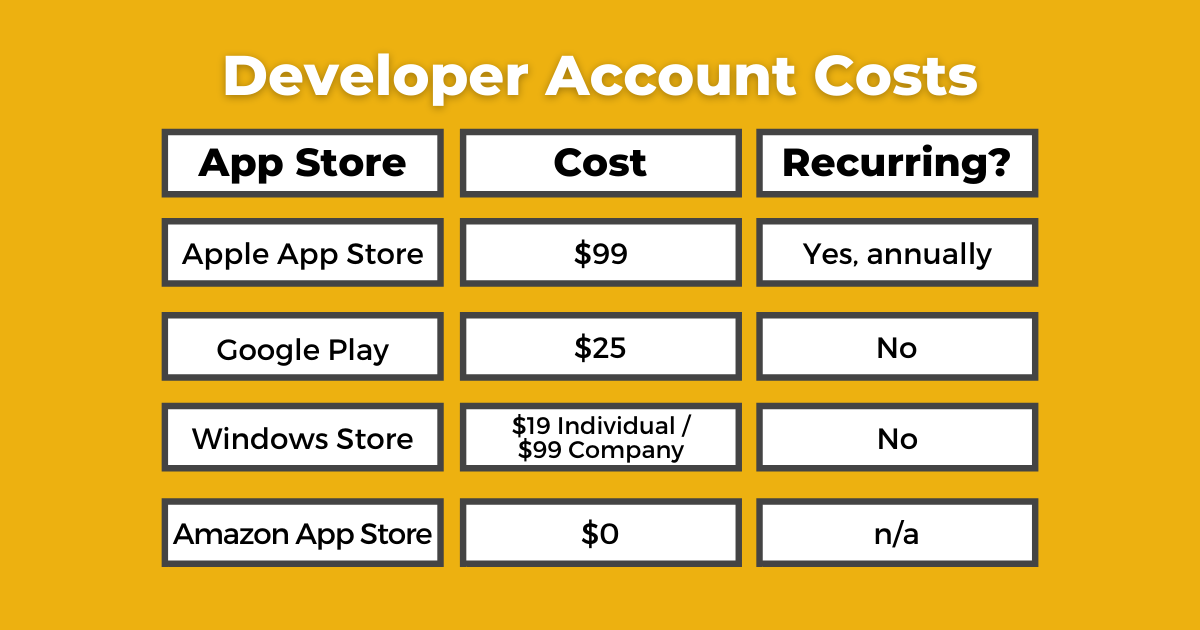The Hidden Costs of App Development
Published on October 29, 2020

This post was originally written in 2013, but we've updated it to be more accurate in 2020.
App development can be an expensive endeavor. A seemingly simple idea could end up being technically difficult or time-consuming to develop.
When you're crafting the budget for your next app project, be sure to keep these few things in mind:
App Store Costs
In order to list your app in an app store, you'll need to pay for a developer account. Right now, the cost break down looks like this:

In addition to the yearly fee, all app stores take a portion of your profits in order to pay for distribution costs. Right now, the fees look like this:

Some big names are going to bat for all developers in a fight against these commission rates. We discuss the ongoing controversies in this podcast episode: Apple vs Developers.
Backend Development
The app development process is often broken up into two distinct processes: the front end and the backend.
The front end is almost always the app that you would use on an iPhone or Android device. The backend, however, is a separately-hosted program that synchronizes data between the app and databases.
We won't get too technical with our discussion on the backend, but if you're planning on using any of the following functionalities in your app, be sure you discuss any potential costs with your developer:
- Push Notifications
- Syncing Devices
- Group Chat
- Search
Server Costs
If your app requires a central service to keep data in sync, or if you want to perform tasks like push notifications, you'll need to deal with the costs of operating your own server.
For starters, all sites will need a domain name, which typically costs anywhere from $0.99 to $12 per year. However, if you have a specific domain name in mind but someone else already owns it, expect the cost to go way up. It might not be as ridiculous as buying a site for $350 million, but a five-figure price isn't out of the question.
Next, you'll need to consider what type of server infrastructure to use. Depending on the type of hosting required, the cost could be as little as $2.50 per month or up to several hundred dollars per month. While it’s unlikely you’ll need to build your own data center, even if you are looking to launch the next Facebook, this is another cost to keep in mind when you're crafting your project's overall budget.
One way to cut server costs at the outset is to use a third-party solution like Firebase. These types of “backends as a service” are specifically designed to transfer data back and forth between apps, provide the infrastructure for things like search and push notifications, and allow you to scale your infrastructure when your app really takes off. The only downside is that as your app gains users, the costs for these platforms becomes astronomically higher.
Regardless of what infrastructure you choose, you should work with your development team to understand the type of budget you’ll need to set aside every month for server expenses.
Design Work
At a minimum, developers will build your app using basic, "stock" design elements. If you are looking to really stand apart in the market, you might want to consider hiring a separate designer to build a more unique layout. Bring this up with your developer while you're negotiating your contract.
Game Development
Games are among the most expensive types of apps to develop. Grand Theft Auto V reportedly cost $265 million to develop and market. An average Xbox/Playstation game costs as high as $28 million.
By comparison, mobile games aren't that expensive, but they can soar quickly into the six figure range (and beyond) depending on what type of game you have in mind.
Are you looking for something like a trivia app or something with very low graphical requirements? You might be able to get your app developed for less money than if your app required 3D graphics, augmented reality integration, and multiplayer support.
Supporting Multiple Platforms
Porting your app from one platform to another (say, iPhone to Android) is not as easy as you'd think. Often, the entire app needs to be re-written in a completely different language in order to jump to another platform.
Learn more about developing for iOS versus Android.
While you're in the initial stages of development for your app, think about the platforms that make the most sense for you.
Are you looking to make more money per user? Perhaps you want to stick to iOS.
Do you need to reach the largest possible audience? Android might look more tempting to you.
Even within just "iOS" and "Android", you'll need to discuss which devices you need support for.
Are you looking for both iPad and iPhone support? Does your app need to function on every Android-powered device on the market? Warning: That figure may cause sticker shock.
Can you build your app to only run on the latest operating systems (iOS 14 / Android 10) or do you need to support legacy systems and customers?
A great way to reduce costs in this area is to test the waters by targeting only the most recent devices and operating systems. As your app grows in popularity, you can add more devices and operating systems.
We often get asked for ballpark estimates for various types of apps, and we've found that most projects fall within four ballparks. Visit our Pricing page to learn more: https://jmg.mn/pricing.
While it’s difficult to pinpoint every cost you could possibly encounter when developing an app, an experienced development team can help you balance the needs of your users and the limitations of your budgets.
 Tim Bornholdt
Tim Bornholdt